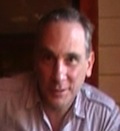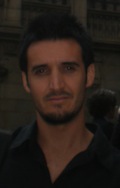Keynote Speakers
The InMed'14 conference will feature a number of prominent keynote speakers. The speakers and the titles of their talks are shown below.
Edward J. Ciaccio
Columbia University, NYModel of Reentrant Ventricular Tachycardia based on Wavefront Curvature
More details ...
Jesus Cortes
Biocruces, Ikerbasque, SpainComputational Neuroimaging for health and disease
More details ...
Juan Manuel Gorriz
University of Granada, SpainDiagnoSIS: Diagnosis by means of Statistical and Intelligent Systems
More details ...
Ricardo Sanchez Peña
ITBA & CONICET, ArgentinaAutomatic Control of Diabetes type 1
More details ...
Sebastiano Stramaglia
Ikerbasque Visiting Professor, SpainCausality measures for Brain Computation
More details ...
Edward J. Ciaccio
Columbia University, NYModel of Reentrant Ventricular Tachycardia based on Wavefront Curvature
Abstract:
Ventricular tachycardia is one of the most common heart arrhythmias, and without treatment it can lead to disability or cardiac arrest. The cause of the tachycardia is often a double-loop reentrant circuit, in which two activation wavefronts propagate simultaneously around a common isthmus. Currently, radiofrequency catheter ablation is used to target the arrhythmogenic region of reentrant ventricular tachycardia with minimal invasiveness during electrophysiologic study. However, correct targeting is not always possible due to the difficulty in identifying the arrhythmogenic regions responsible for all clinical tachycardias that may occur in a particular patient, and because of hemodynamic compromise which prevents successful mapping of the heart surface for some or all clinically relevant tachycardias. If a method could be devised to detect arrhythmogenic regions in the heart during electrophysiologic examination without the need for tachycardia induction, or at least without the need for extensive mapping during tachycardia, it could go a long way toward the successful treatment of these patients, as well as to reduce the fluoroscopy time needed for evaluation.
We have devised a model to explain electrogram fractionation and functional electrical conduction block in the postinfarction heart based on activation wavefront curvature. When the activation wavefront travels without impediment, its leading edge is linear in shape and it travels at approximately 0.5 millimeters per millisecond. However, when it encounters a sharp change from lesser to greater conducting volume during propagation, the wavefront becomes convex and slows, due to the relative reduction in available current to activate distal viable tissue. Under certain conditions this can lead to very slow conduction or functional block. We have identified these conditions as occurring at lateral boundaries present on either side of the isthmus of the reentrant circuit. At these locations, there is a sharp change from very thin to thicker infarct border zone, which is the region of surviving myocardial cells between infarct and heart surface. A reentrant circuit loop travels around each lateral boundary during tachycardia. Furthermore, because of the variability in thin-to-thick infarct border zone at the lateral boundaries, the model shows that the electrical activation wavefront can become discontinuous there and result in electrogram fractionation, which is a reduced amplitude signal with multiple random deflections. By targeting ablation energy across the lateral boundaries, it would be possibly to prevent reinduction of tachycardia, including those clinical tachycardias that are not readily mappable by current methods.
In our most recent work, we show how wavefront curvature can be used to explain reentry onset during premature excitation of the heart. The model suggests that only by pacing from certain locations and at certain coupling intervals will the conditions conducive to reentry initiation be met, and that based on the mechanism, the reentry morphology must always be in the form of a double loop. Thus, it may be possible to improve the success rate for clinical tachycardia induction and mapping during electrophysiologic study by more accurately predicting at what locations will premature excitation lead to successful induction of reentrant tachycardia. Furthermore, we show that the size and shape of the reentry isthmus is constrained to certain dimensions. All of these findings are potentially useful for improved and rapid targeting of arrhythmogenic regions in patients with reentrant ventricular tachycardia.

Biography:
Edward J. Ciaccio Ph.D. is a senior research scientist in the Department of Medicine - Division of Cardiology at Columbia University Medical Center in New York City, which he joined in 2010. Dr. Ciaccio also works part-time for the Celiac Disease Center at Columbia University Medical Center. He was staff and research faculty with the Department of Pharmacology, Columbia University Medical Center from 1990 - 2010. He also taught as an adjunct assistant professor in the Department of Biomedical Engineering, Columbia University from 1996 - 2006.
Dr. Ciaccio's research expertise includes biosignal analysis (cardiac electrophysiology), and bioimage analysis (video capsule studies for celiac disease). His group has developed a new spectral estimator and transform for the analysis of biomedical data. These quantitative methods have been used to detect dominant frequency components and dominant time-series patterns in atrial fibrillation and ventricular tachycardia electrograms. This work also includes the implementation of a real-time spectral estimator. Dr. Ciaccio's group has developed models to explain electrogram fractionation and functional electrical conduction block in postinfarction hearts. In the area of computer hardware, the group has designed a fast data acquisition and electrical activation mapping system with multichannel inputs.
Dr. Ciaccio has received an Established Investigator Award from the American Heart Association (1998) and a Paper of the Year Award from Heart Rhythm Journal (2008). He became editor-in-chief of Computers in Biology and Medicine in January 2013. He is also an editorial board member for BioMedical Engineering OnLine, Heart Rhythm, Journal of Cardiovascular Electrophysiology, World Journal of Gastroenterology, and World Journal of Gastrointestinal Endoscopy. Dr. Ciaccio reviews for over 30 scientific journals and has published over 80 peer-reviewed articles in his field. His current research focus includes the development of a wavefront curvature model of reentrant ventricular tachycardia.
Jesus Cortes
Biocruces, Ikerbasque, SpainComputational Neuroimaging for health and disease
Abstract:
Modern neuroimaging methods can shed light on the basis of neuronal and cognitive specializations, with important implications for neuroscience and medicine. In particular, there is a growing interest in determining what aspects of brain function can be understood from what exact features of brain structure. I will speak on recent results developed in our lab, with applications to clinical data. Further information at http://www.biocruces.com/l1003

Biography:
Prof. Jesus M Cortes is the head of the Computational Neuroimaging Lab and the scientific coordinator of the Quantitative Biomedicine Unit in Biocruces. After his PhD in Physics at the University of Granada in Spain, he performed postdoctoral research in several world-leading Institutions across the world, including the Radboud University Nijmegen The Netherlands (Prof. Bert Kappen), The Salk Institute for Biological Studies USA (Prof. Terry Sejnowski) and the University of Edinburgh UK (Prof. Mark van Rossum). Although trained in physics and computer science, Dr. Cortes moved to Neuroscience to apply quantitative and computational methods to neuronal data. In particular, Dr. Cortes is currently focused on the applications of statistical methods and Information Theory to neuroimaging data. He has more than 38 peer-reviewed publications and has given 41 official scientific talks. Among many other merits, he got "PhD with Distinction" in Science at the University of Granada Spain, a Fulbright Postdoctoral Visitor Fellowship, a Ramon y Cajal Fellowship and became the Spanish Ambassador of the first-class Neural Information Processing Systems Conference (NIPS 2011).
More information at http://jesuscortes.info
Juan Manuel Gorriz
University of Granada, SpainDiagnoSIS: Diagnosis by means of Statistical and Intelligent Systems
Abstract:
Aim of diagnoSIS project is to develop, implement, validate and integrate patient-specific computer-based models of cerebral neurodegeneration, characterizing different stages and types of dementia diseases, to be used for early and differential diagnosis of Alzheimer (AD) and Parkinson (PD) diseases. These models, which describe several stages and types of dementia, are based on existing, intensive, computer-based statistical and intelligent systems taking advantage of large and shared datasets of structural (MRI) and functional (SPECT, PET) imaging studies of normal and pathological populations (i.e. ADNI or PPMI databases). The models are at a multiscale level (from image voxels to volumes up to the whole brain, from cellular to molecular and tissue up to the whole brain), and integrate physiological and molecular information (i.e. cerebral glucose metabolism) with anatomical information (i.e. atrophy) across different levels (from individual brains to populations of brains). Models of multimodal images for specific validation (i.e. PET/MRI images from new prototype combined PET/MRI scanners), will be implemented based on novel paradigms in statistical learning theory and signal processing. Crucially, by the use of these computer-based models and databases, a subject-specific brain function/anatomy measurement can be processed at a single-subject basis and cerebral abnormality can be detected.
At the classification stage, diagnoSIS proposes statistical classifiers based on support vector machine, artificial neural network, random forest, Gaussian process and sparsity-based models, texture-based and statistical voxel-based models. At the feature extraction stage parametrical and unsupervised models are analyzed for MRI segmentation and many other approaches, such as empirical mode decomposition (EMD), non negative matrix factorization (NMF), association rules (ARs), etc., are studied as well, for multi- modality image processing.
The increased predictive and diagnostic accuracy afforded by such models can lead to greatly accelerate clinical translation and diagnoSIS has the potentials, with the support given by several international initiatives to really represent a turning point in the actual methods to perform diagnosis, not only in dementia.

Biography:
Juan Manuel Górriz was born in Almería, Spain in 1976. He received a BSc. in Physics (2000) and a BSc. in Electronic Engineering (2001) from the University of Granada (UGR), Spain. He then earned a PhD from the University of Cádiz (2003) and a PhD from the University of Granada (2006). Dr.Dr. Górriz is a full Professor with the Department of Signal Theory, Networking and Communications at the UGR. He has coauthored more than 200 technical journals and conference proceedings and served as editor for several journals and books. His present interests lie in the field of statistical signal processing and its application to medical image processing.
Ricardo Sanchez Peña
ITBA & CONICET, ArgentinaAutomatic Control of Diabetes type 1
Abstract:
This talk considers the autonomous control of glucose levels in diabetes type 1 patients. The connection of a continuous glucose monitor with an insulin pump by means of a control algorithm is the focus of this work. Different mathematical models and their use in the design of control algorithms as well as in performance simulations will be discussed. An overview of several control techniques and recent results by the author using FDA-approved simulations will be presented.

Biography:
Ricardo Sánchez Peña received the Electronic engineer degree from the University of Buenos Aires (Argentina) in 1978, the M.S. and Ph.D. degrees from the California Institute of Technology (USA) in 1986 and 1988, respectively. He worked in CITEFA (1977-1979), CNEA (1989-1994) and the argentine Space Agencies, CNIE (1979-1984) and CONAE (1994-2004) with collaborations for NASA, DLR (Germany), Zona-Tech (Phoenix) and CTA/INPE (Brazil). He was Professor at the University of Buenos Aires (1989-2004), ICREA Research Professor at the UPC, Spain (2005-2009), and visiting Researcher/Professor at Universities in USA and EU. He published 3 books and more than 130 journal and conference papers. Since 2009, he is the head of the Ph.D. program at the Buenos Aires Institute of Technology (ITBA) and CONICET Principal Investigator. He is interested in Identification and Control theory and algorithms and has applied them to acoustics, mechanics, aero & astronautical engineering and in the last years to Diabetes type 1.
Sebastiano Stramaglia
Ikerbasque Visiting Professor, SpainCausality measures for Brain Computation
Abstract:
The inference of information flow between dynamical subsystems, from data, is a topic of general interest, in particular in neuroscience. Transfer entropy and Granger causality are popular methods to distinguish effectively driving and responding elements and to detect asymmetry in the interaction of neuronal subsystems. Granger causality is based on prediction: if the prediction error of the first time series is reduced by including measurements from the second one in the linear regression model, then the second time series is said to have a causal influence on the first one. I will describe the recent advances in the field, which cope general problems, like the presence of redundancy in the data, as well as peculiar issues to EEG and fMRI modalities.

Biography:
His background is on Statistical Mechanics, and since 1997 he has been applying concepts and methodologies from Statistical Mechanics and Machine Learning to the modelling and data analysis of neural networks and biological systems.
The present research activity focuses on the inference of functional and effective brain connectivity from brain signals.





